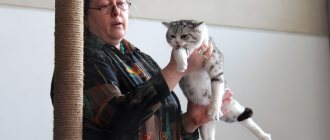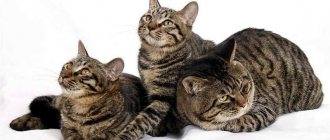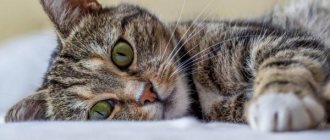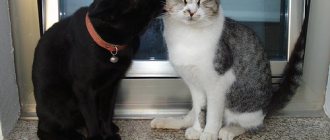There is an opinion that the steppe cat is one of the very first representatives of cats. It is believed that they existed on Earth long before the appearance of man.
They are the ancestors of modern pets. Once upon a time, cats were first domesticated in Ancient Egypt and became sacred there. Steppe cats are otherwise called “savages”. Visually, they resemble domestic cats, but they lead a wild lifestyle, which is why they differ from their counterparts.
Appearance
The wild steppe cat is a subspecies of the wild forest cat. Outwardly they are very similar, but there are also significant differences. They are more like ordinary domestic cats.
Features of the appearance of the steppe cat:
- The animals have a long and muscular body, the length of which can reach 80 centimeters. This is not to say that these are big cats;
- The weight of steppe cats does not exceed 6 kg;
- The animal's paws are strong and strong, of medium length;
- The tail is long and thin, can reach 25 centimeters in length;
- The cat's head is small in size, the muzzle is slightly elongated;
- This cat has large eyes;
- The animal has large ears, with tassels at the tips;
- The animals' fur is short but thick. In winter, the fur remains the same length, which distinguishes it from the forest cat;
- The color of steppe cats is inconspicuous, usually gray or sandy.
In a word, the steppe cat is very easy to confuse with a domestic cat.
Reproduction and care of offspring
Steppe cats prefer to lead a solitary lifestyle . Each male has his own territory, which he jealously guards from the invasion of other cats. The females also help guard the territory, settling not far from the males, and, if necessary, join their efforts to drive away the strangers.
The mating season for these animals lasts from January to March. Interestingly, unlike domestic cats, steppe cats are rather quiet creatures and try not to attract attention by screaming and meowing. Only during the mating season, these cats can make different sounds, from loud meows to snorting and growling.
A female ready for mating can be courted by several males, and she chooses the largest and healthiest male as the father for future offspring. After courtship and mating, the male leaves the female and does not take any part in raising future offspring.
The pregnancy of a steppe cat lasts from two to two and a half months. As a nest, the female builds a hole or hollow in a tree. Young females give birth to one or two babies, while more mature individuals have up to six kittens in a litter. But most often, steppe cats give birth to no more than three babies. Kittens are born blind and helpless, and for the first six months they are completely dependent on the care of their mother.
Steppe cats have a highly developed maternal instinct, and they never abandon their offspring. Two weeks after birth, the kittens' eyes open, and a month later, the babies are already covered with fur and look like a smaller copy of their parents.
The female feeds the cubs with milk for more than two months, and only after this period has passed does she begin to accustom the kittens to adult food. First, the steppe cat brings the kids small rodents caught during the hunt. As the kittens grow older, the female brings live prey to her “nest,” teaching the cubs to hunt on their own.
For two to three months, steppe cat kittens do not leave the parental den; after this period, the cubs begin to go hunting with their mother. The steppe cat takes care of its babies for six to seven months, then the matured kittens begin an independent life. Sexual maturity of steppe cats occurs a year after birth, but usually, males are ready to breed only at the age of two.
Habitat
African wild cat is another name for the animal. This name is closely related to its habitat. Steppe cats live in the vastness of Africa and Asia.
They can also be seen in Russia, but they are found only in the Astrakhan region in semi-desert areas.
They prefer to live near bodies of water where there are thickets and where they can hide to hunt for prey. Open areas are not suitable for the steppe cat. There they can become prey for large predators. Cats also do not like to settle in areas covered with snow because they are visible there.
www.zoo-ekzo.ru – Sale of exotic animals
Steppe cat, or African wild cat, or steppe cat (Felis silvestris lybica, or Felis lybica)
Class - mammals Order - carnivores Family - felines
Subfamily - small cats
Genus - cats
Appearance
The steppe cat can be sandy-brown to yellow-gray in color with black stripes on its tail. The coat is shorter than that of the European cat. Body length from 45 to 75 cm, tail - from 20 to 38 cm. Weight from 3 to 6.5 kg.
The eyes glow green at night.
Habitat
The steppe cat lives in steppe, desert and sometimes mountainous regions of Africa, Western, Middle and Central Asia, Northern India, Transcaucasia and Kazakhstan.
In nature
The steppe cat mainly feeds on mice, rats and other small mammals. When the opportunity arises, it can also feed on birds, reptiles, amphibians and insects. While hunting, cats slowly creep up to their prey and attack from a distance of about one meter. Steppe cats are mainly active at night and at dusk. During clashes with an enemy, the steppe cat raises its fur to appear larger and intimidate the enemy. During the daytime, it usually hides in bushes, but is sometimes active on dark cloudy days. The male's territory partially overlaps with the territories of several females, who protect it from intruders. Females give birth to two to six kittens, but usually three. The steppe cat rests and raises kittens in burrows or pits.
Reproduction
Females reach sexual maturity after 9-10 months, while males only in the third year of life. Pregnancy lasts from 56 to 69 days. Kittens are born blind and require maternal care. Most kittens are born during the rainy season when food is plentiful. They stay with their mother for 5-6 months, and after a year they are already capable of reproduction. During the rutting period, fierce fights between males occur, accompanied by loud screams.
Captivity
The best way to gain the respect of an animal is to hand feed it from childhood. This way he will know that your presence is safe for him.
Do not play the game of “fighting with an arm or a leg” with a kitten - it is better to use his toys for this, otherwise, as he grows up, he will perceive your arms and legs as his toys, scratching and biting them. It is recommended to play with the cat in the bathtub or pool using “floating” toys.
You cannot shout at the cat or hit it. For example, if he constantly climbs onto the dining table, then he needs to be punished with a spray bottle or an air pump. Give a clear command: “No!” and “blow” with a strong stream of air. The steppe cat will learn the lesson very quickly and in other situations just one command will be enough.
If the cat is playing and scratches you during the game, then just leave him alone in the room. Believe me, he will very soon realize that he is doing something wrong if he is left alone. These animals are extremely intelligent and require initial training, just like dogs.
It is important that the steppe cat receives attention from all family members whenever possible. You are his parents (his pack) in which he feels safe and responds for this with gratitude and affection.
The steppe cat must be trained to use a litter box (preferably wood litter). If he went to the toilet in the wrong place, you should not scold him; it is enough to explain it to him verbally, showing him the correct place. Keep the toilet clean.
Steppe cats require vaccination, the same as domestic cats. However, make sure that the vaccine is of high quality and does not contain active viruses. Otherwise, the animal may get sick and die. It is very important. Your pet cannot explain to you what is hurting him, so if you notice any strange behavior or movement, contact your veterinarian immediately.
Regarding nutrition: the diet of cats consists mainly of raw meat with bones - poultry and beef (for example, chicken or quail thighs, wings, hearts, liver, necks). It is advisable to add special vitamins with calcium supplements to the diet. Adult cats eat 0.3 to 0.8 kg of meat per day.
Lifestyle
The steppe cat is a predator just like a domestic cat. African cats have their own wild characteristics. They prefer to live along the banks of reservoirs and are not at all afraid of water, they can even swim across the river.
But snow is a problem for the African predator; they do not like to hunt on snow cover. Predators also lead a solitary cat-like lifestyle, excluding mating seasons.
Predators spend most of their time in shelters; they can occupy the burrows of foxes, porcupines and other animals, or hide in thickets of bushes.
When encountering a dangerous predator, the cat raises its tail and arches its back, its fur begins to stick out on end. If the enemy continues to attack, she lies on her back and begins to fight him off with all four paws, releasing sharp claws. At the first opportunity, he prefers to run away and hide in a shelter.
The animal's meal is usually small rodents or birds; the predator is not able to hunt larger prey than a hare.
Character and lifestyle of the steppe cat
When you hear the word “cat,” you most often imagine a fast, energetic animal, but energy and mobility are not at all characteristic of Pallas’ cat. He just can't run fast. Jumping and climbing trees is also not his taste. In addition, the cat gets tired too quickly. It is preferable for him to sleep all day and only go hunting at night.
Big company is also not to the liking of the fluffy couch potato. It is much better for him to sit comfortably in an abandoned fox or badger hole and rest until nightfall.
Since the Pallas cat does not greet his “interlocutors,” there is no one in particular to give him a voice. It is impossible to wait for songs and heartfelt screams from the steppe cat even in the most romantic periods of his life.
True, in exceptional cases he can purr in a hoarse voice, or snort with displeasure, that’s all he’s capable of. Wildcat Hunter is excellent. He has a lot of patience and endurance. The Pallas's cat can lie for a long time in the snow or among the foliage, tracking down its prey.
As prey, he chooses not too large animals - mice and birds. However, it can also cope with an animal of similar weight, for example, a hare. Of course, if the hare does not flee.
When hunting in winter, the Pallas's cat chooses places that are not too covered with snow, because his rich fur coat in the snowdrifts does him no good at all - because of it, the cat simply gets stuck in the snow.
Pallas' cat diligently avoids people; moreover, even when they are found as kittens, they are very poorly tamed, treat people with distrust and abandon their wild habits for the rest of their lives.
Even in zoos, Pallas' cats began to appear only when, with the advent of the Internet, photos of the steppe cat and great interest arose in them.
True, the cat was already popular among local residents, because its luxurious fur is true wealth. Therefore, the cat has good reason to be careful.
In the natural environment, the number of cats is reduced by owls, wolves and eagle owls. It is not easy for the Pallas's cat to escape from these predators, because he cannot always escape by running due to his slowness; all he can do is snort and bare his teeth. Cats are listed in the Red Book.
Wild cat nutrition
The African wild cat prefers to hunt animals such as small rodents, birds, and hares. The diet may also include insects and lizards. The most common rodents eaten are mice, gophers and jerboas.
Among the birds, pheasants and sparrows are distinguished, and they also prefer to hunt domestic chickens. Cats are excellent at climbing trees thanks to their long and sharp claws, climbing into bird nests and happily eating their eggs.
They can eat amphibians, and in water cartilaginous fish become food for the African cat.
Subspecies
Based on research[6] of mitochondrial DNA from 979 domestic and wild cats from Europe, Asia and Africa, Felis silvestris lybica
split from the European wildcat about 173 thousand years ago and from the subspecies
Felis silvestris ornata
and
Felis silvestris cafra
about 131 thousand years ago.
About 10,000 years ago, 5 representatives of Felis silvestris lybica
were domesticated in the Middle East with the beginning of the development of agriculture and the appearance of the first Neolithic agricultural settlements during the transition of man from hunting and gathering to a sedentary lifestyle in the first stages of the development of human civilization[6].
Now a separate species is distinguished - the African steppe cat Felis lybica
Forster, 1780, and the term
Felis silvestris
belongs to the European forest cat.
Steppe cats in captivity
It is not difficult to meet a wild animal in a zoo. It should be noted that their life expectancy is low; they rarely live more than 6 years. In zoos, African cats live much longer.
It is believed that the steppe cat is an animal that has no place among people. However, if you start accustoming him to social life from infancy, then it is quite possible to raise an obedient cat.
Steppe cats are wild predators that live in semi-desert areas, often near bodies of water, where there are many thickets and other opportunities for shelter. They feed mainly on small rodents, birds and their eggs.
The most dangerous enemy of an animal is a wild dog. The life expectancy of a steppe cat in the wild is short - about 6 years. You can meet African cats at the zoo and even have a kitten at home.
Features and habitat of the steppe cat
The steppe manul cat is a subspecies of wild forest cat. Representatives of this particular subspecies became the progenitors of the common pet. They were domesticated many years ago and have successfully made their home on our sofas.
However, not all wild cats began to live with humans; there are some that still live a wild, free life. Wild representatives are not large, their size barely reaches 75 cm, their tail is from 20 to 40 cm, and their weight ranges from 3 to 7 kg.
In general, the manul looks like a domestic, well-fed cat. Only the expression on his face is too dissatisfied. Perhaps this expression is a consequence of the special arrangement of spots on the forehead, or perhaps the light sideburns add severity.
But the appearance of satiety is given to him by his dense physique, strong, short legs and, most importantly, luxurious, thick and fluffy fur. It’s worth talking about wool separately. In general, the Pallas's cat is considered the fluffiest animal of the cat family.
On its back alone, there are up to 9,000 hairs per square centimeter. The length of the coat reaches 7 cm. It is interesting that the color of such a fur coat is light gray, smoky or red, but the tip of each hair is painted white, and this gives the entire coat a silvery patina.
The fur coat is not uniform, there are spots and stripes. The ears of this forest beauty are small, and in the luxurious fur they are not immediately noticeable. But the eyes are large, yellow and the pupils are not oblong, but round.
Both the eyesight and hearing of the Pallas's cat are excellent. This is understandable - forest dwellers simply need them. But what’s surprising is that the cat’s sense of smell is weak, it is poorly developed.
This steppe cat feels comfortable in steppe areas or semi-deserts. Pallas' cats have settled from Iran to Asia; they can be found in China and even in Mongolia. Cats are especially comfortable among low bushes, as well as among small rocks - this is where they prefer to settle.











